高三英语数词、介词和连词
- 格式:pdf
- 大小:1.09 MB
- 文档页数:9
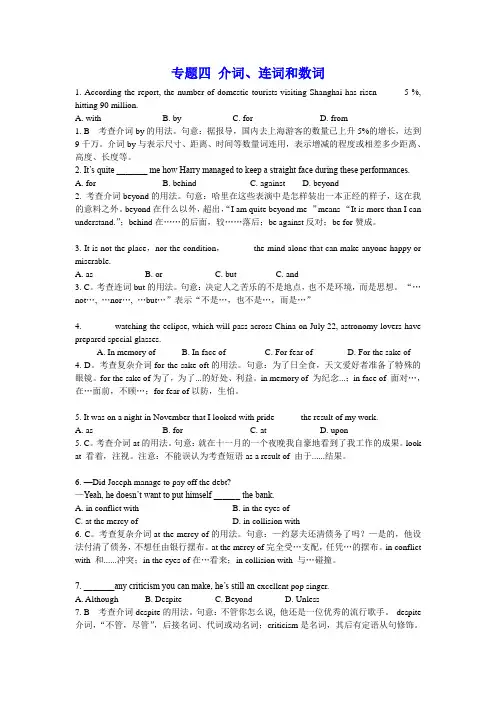
专题四介词、连词和数词1. According the report, the number of domestic tourists visiting Shanghai has risen _____ 5 %, hitting 90 million.A. withB. byC. forD. from1. B 考查介词by的用法。
句意:据报导,国内去上海游客的数量已上升5%的增长,达到9千万。
介词by与表示尺寸、距离、时间等数量词连用,表示增减的程度或相差多少距离、高度、长度等。
2. It’s quite _______ me how Harry managed to keep a straight face during these performances.A. forB. behindC. againstD. beyond2. 考查介词beyond的用法。
句意:哈里在这些表演中是怎样装出一本正经的样子,这在我的意料之外。
beyond在什么以外,超出,“I am quite beyond me ”means “It is more than I can understand.”;behind在……的后面,较……落后;be against反对;be for赞成。
3. It is not the place,nor the condition,______ the mind alone that can make anyone happy or miserable.A. asB. orC. but C. and3. C。
考查连词but的用法。
句意:决定人之苦乐的不是地点,也不是环境,而是思想。
“…not…, …nor…, …but…”表示“不是…,也不是…,而是…”4. _______watching the eclipse, which will pass across China on July 22, astronomy lovers have prepared special glasses.A. In memory ofB. In face ofC. For fear ofD. For the sake of4. D。
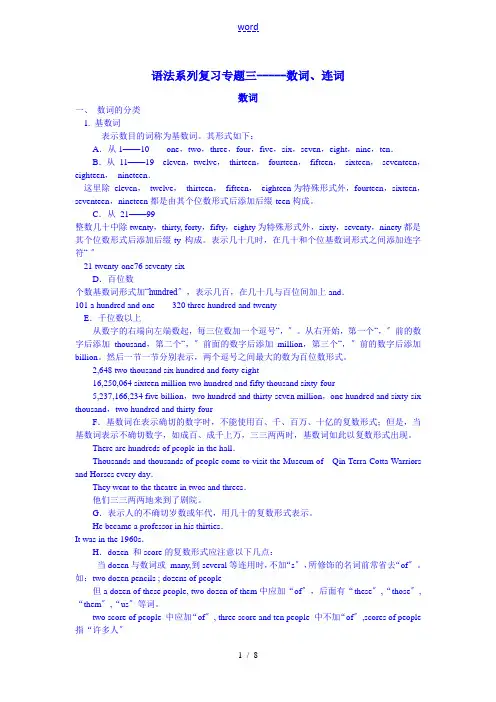
语法系列复习专题三-----数词、连词数词一、数词的分类1. 基数词表示数目的词称为基数词。
其形式如下:A.从1——10one,two,three,four,five,six,seven,eight,nine,ten.B.从11——19eleven,twelve,thirteen,fourteen,fifteen,sixteen,seventeen,eighteen,nineteen.这里除eleven,twelve,thirteen,fifteen,eighteen为特殊形式外,fourteen,sixteen,seventeen,nineteen都是由其个位数形式后添加后缀-teen构成。
C.从21——99整数几十中除twenty,thirty, forty,fifty,eighty为特殊形式外,sixty,seventy,ninety都是其个位数形式后添加后缀-ty构成。
表示几十几时,在几十和个位基数词形式之间添加连字符“-〞21 twenty-one76 seventy-sixD.百位数个数基数词形式加“hundred〞,表示几百,在几十几与百位间加上and.101 a hundred and one320 three hundred and twentyE.千位数以上从数字的右端向左端数起,每三位数加一个逗号“,〞。
从右开始,第一个“,〞前的数字后添加thousand,第二个“,〞前面的数字后添加million,第三个“,〞前的数字后添加billion。
然后一节一节分别表示,两个逗号之间最大的数为百位数形式。
2,648 two thousand six hundred and forty-eight16,250,064 sixteen million two hundred and fifty thousand sixty-four5,237,166,234 five billion,two hundred and thirty-seven million,one hundred and sixty-six thousand,two hundred and thirty-fourF.基数词在表示确切的数字时,不能使用百、千、百万、十亿的复数形式;但是,当基数词表示不确切数字,如成百、成千上万,三三两两时,基数词如此以复数形式出现。
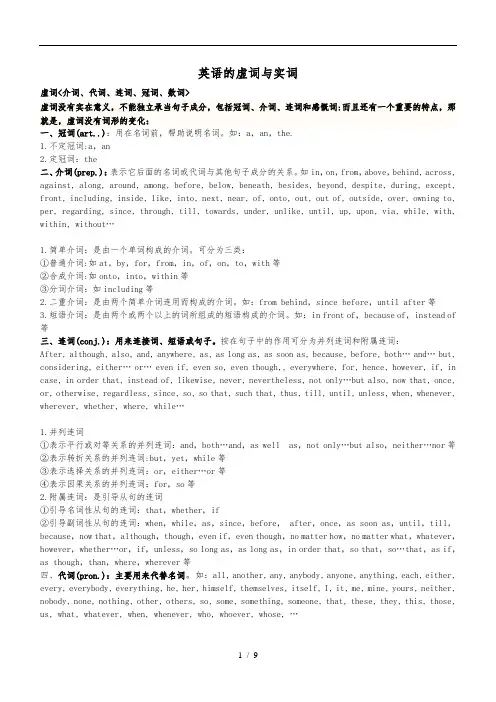
英语的虚词与实词虚词<介词、代词、连词、冠词、数词>虚词没有实在意义,不能独立承当句子成分,包括冠词、介词、连词和感慨词:而且还有一个重要的特点,那就是,虚词没有词形的变化:一、冠词(art..):用在名词前,帮助说明名词。
如:a,an,the.1.不定冠词:a,an2.定冠词:the二、介词(prep.):表示它后面的名词或代词与其他句子成分的关系。
如in,on,from,above,behind, across, against, along, around, among, before, below, beneath, besides, beyond, despite, during, except, front, including, inside, like, into, next, near, of, onto, out, out of, outside, over, owning to, per, regarding, since, through, till, towards, under, unlike, until, up, upon, via, while, with, within, without…1.简单介词:是由一个单词构成的介词。
可分为三类:①普通介词:如at,by,for,from,in,of,on,to,with等②合成介词:如onto,into,within等③分词介词:如including等2.二重介词:是由两个简单介词连用而构成的介词。
如:from behind,since before,until after等3.短语介词:是由两个或两个以上的词所组成的短语构成的介词。
如:in front of,because of,instead of 等三、连词(conj.):用来连接词、短语或句子。
按在句子中的作用可分为并列连词和附属连词:After, although, also, and, anywhere, as, as long as, as soon as, because, before, both…and…but, considering, either… or… even if, even so, even though,, everywhere, for, hence, however, if, in case, in order that, instead of, likewise, never, nevertheless, not only…but also, now that, once, or, otherwise, regardless, since, so, so that, such that, thus, till, until, unless, when, whenever, wherever, whether, where, while…1.并列连词①表示平行或对等关系的并列连词:and,both…and,as well as,not only…but also,neither…nor等②表示转折关系的并列连词:but,yet,while等③表示选择关系的并列连词:or,either…or等④表示因果关系的并列连词:for,so等2.附属连词:是引导从句的连词①引导名词性从句的连词:that,whether,if②引导副词性从句的连词:when,while,as,since,before, after,once,as soon as,until,till,because,now that,although,though,even if,even though,no matter how,no matter what,whatever,however,whether…or,if,unless,so long as,as long as,in order that,so that,so…that,as if,as though,than,where,wherever等四、代词(pron.):主要用来代替名词。
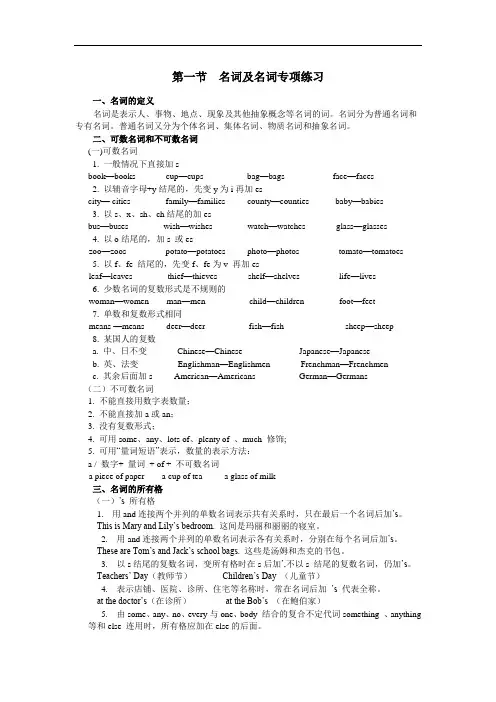
第一节名词及名词专项练习一、名词的定义名词是表示人、事物、地点、现象及其他抽象概念等名词的词。
名词分为普通名词和专有名词。
普通名词又分为个体名词、集体名词、物质名词和抽象名词。
二、可数名词和不可数名词(一)可数名词1. 一般情况下直接加sbook—books cup—cups bag—bags face—faces2. 以辅音字母+y结尾的,先变y为i再加escity— cities family—families county—counties baby—babies3. 以s、x、sh、ch结尾的加esbus—buses wish—wishes watch—watches glass—glasses4. 以o结尾的,加s 或eszoo—zoos potato—potatoes photo—photos tomato—tomatoes5. 以f、fe 结尾的,先变f、fe为v 再加esleaf—leaves thief—thieves s helf—shelves life—lives6. 少数名词的复数形式是不规则的woman—women man—men child—children foot—feet7. 单数和复数形式相同means —means deer—deer fish—fish sheep—sheep8. 某国人的复数a. 中、日不变Chinese—Chinese Japanese—Japaneseb. 英、法变Englishman—Englishmen Frenchman—Frenchmenc. 其余后面加s American—Americans German—Germans(二)不可数名词1. 不能直接用数字表数量;2. 不能直接加a或an;3. 没有复数形式;4. 可用some、any、lots of、plenty of 、much 修饰;5. 可用“量词短语”表示,数量的表示方法:a / 数字+ 量词+ of + 不可数名词a piece of paper a cup of tea a glass of milk三、名词的所有格(一)’s 所有格1. 用and连接两个并列的单数名词表示共有关系时,只在最后一个名词后加’s。

高中英语句子结构分析英语的九大词类名词,代词,动词,形容词,副词,数词,连词,介词,冠词。
一、名词(n.):表示人、事物、地点或抽象概念的名称。
物体名--desk,cup,chair.人名--Mike,Li Ming;地名—America ,China 动物名--pig,dog;植物名--tree,wheat.抽象的事物的名称:idea(主意),victory(胜利),knowledge(知识).二、代词(pron.):主要用来代替名词,所以说名词和代词关系是很近的。
代替人的代词有:I,you,he,she,it,they这里要注意,代词的作宾语的形式me,him,her,them....,代替物的代词有:it,that,this,those,these三、动词(v.):"动"就是动作--可以指具体的动作:walk(走),jump(跳),swim(游泳);人的大脑动作(心理活动):think(想),imagine(想象).四、形容词(adj.):用来表示名词的性质或特征。
我们在谈论人或物时,常用上:tall(高的),short矮的),black(黑的),white(白的)这些词往往是修饰名词。
五、副词(adv.):修饰动词、形容词或其他副词,说明动作发生的时间、地点、程度等。
副词很多是从形容词加ly构成的,所以看单词词尾是否有ly是判断是否是副词的一种方法,但是词尾是ly的也不一定都是副词,可能是形容词(likely—有可能的lovely—可爱的friendly—友好的lonely—孤独的weekly—每周一次的monthly—每月一次的yearly—每年一次的)六、介词(prep.):表示它后面的名词或代词与其他句子成分的关系。
at, by, to,in,for,of, on,from,with介词在英语中最常用于介宾结构——介词+名词/代词,起修饰作用.比如:in winter,from America,behind the door等等。
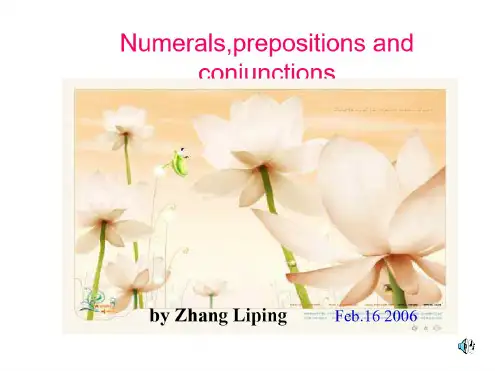
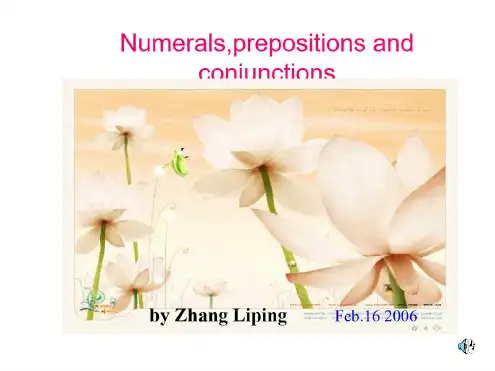
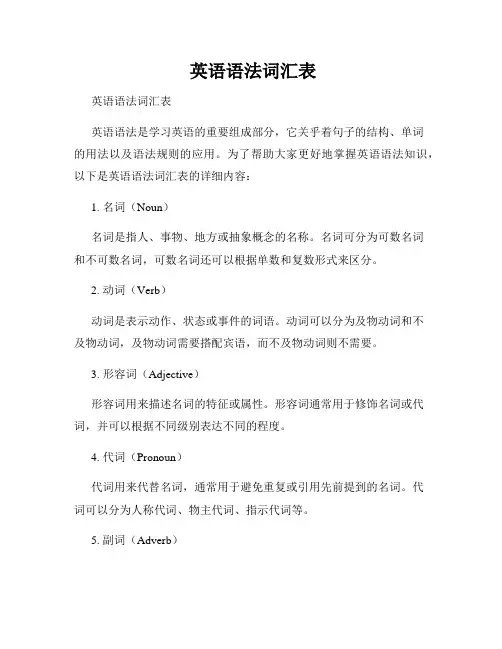
英语语法词汇表英语语法词汇表英语语法是学习英语的重要组成部分,它关乎着句子的结构、单词的用法以及语法规则的应用。
为了帮助大家更好地掌握英语语法知识,以下是英语语法词汇表的详细内容:1. 名词(Noun)名词是指人、事物、地方或抽象概念的名称。
名词可分为可数名词和不可数名词,可数名词还可以根据单数和复数形式来区分。
2. 动词(Verb)动词是表示动作、状态或事件的词语。
动词可以分为及物动词和不及物动词,及物动词需要搭配宾语,而不及物动词则不需要。
3. 形容词(Adjective)形容词用来描述名词的特征或属性。
形容词通常用于修饰名词或代词,并可以根据不同级别表达不同的程度。
4. 代词(Pronoun)代词用来代替名词,通常用于避免重复或引用先前提到的名词。
代词可以分为人称代词、物主代词、指示代词等。
5. 副词(Adverb)副词用来修饰动词、形容词或其他副词,表示时间、地点、方式、程度等。
副词通常以 -ly 结尾。
6. 介词(Preposition)介词用来表达名词或代词与其他词之间的关系,如时间、地点、方式、原因等。
介词通常位于名词或代词之前。
7. 连词(Conjunction)连词用来连接单词、短语或句子。
连词可以分为并列连词、从属连词和关联连词。
8. 冠词(Article)冠词用来限定名词的范围,分为定冠词(the)和不定冠词(a/an)。
9. 数词(Numeral)数词用来表示数字或数量,包括基数词和序数词。
10. 时态(Tense)时态是指动词的形式来表达不同时点的动作或状态,包括一般现在时、过去式、将来时等。
11. 语态(Voice)语态是指动词的形式来表示动作的执行者和承受者之间的关系,包括主动语态和被动语态。
12. 句子类型(Sentence Types)句子可以分为陈述句、疑问句、祈使句和感叹句等不同类型,它们在语法结构和使用方式上有所区别。
13. 主谓一致(Subject-Verb Agreement)主谓一致是指主语和谓语动词在人称和数上要保持一致,即单数主语对应单数谓语动词,复数主语对应复数谓语动词。
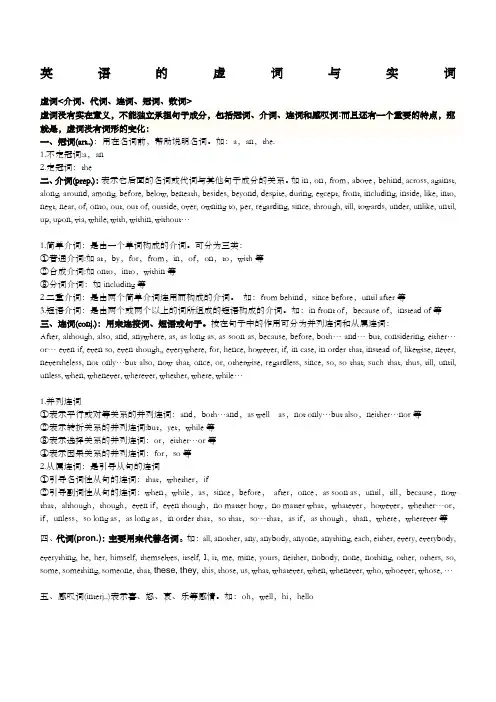
英语的虚词与实词虚词<介词、代词、连词、冠词、数词>虚词没有实在意义,不能独立承担句子成分,包括冠词、介词、连词和感叹词:而且还有一个重要的特点,那就是,虚词没有词形的变化:一、冠词(art..):用在名词前,帮助说明名词。
如:a,an,the.1.不定冠词:a,an2.定冠词:the二、介词(prep.):表示它后面的名词或代词与其他句子成分的关系。
如in,on,from,above,behind, across, against, along, around, among, before, below, beneath, besides, beyond, despite, during, except, front, including, inside, like, into, next, near, of, onto, out, out of, outside, over, owning to, per, regarding, since, through, till, towards, under, unlike, until, up, upon, via, while, with, within, without…1.简单介词:是由一个单词构成的介词。
可分为三类:①普通介词:如at,by,for,from,in,of,on,to,with等②合成介词:如onto,into,within等③分词介词:如including等2.二重介词:是由两个简单介词连用而构成的介词。
如:from behind,since before,until after等3.短语介词:是由两个或两个以上的词所组成的短语构成的介词。
如:in front of,because of,instead of等三、连词(conj.):用来连接词、短语或句子。
按在句子中的作用可分为并列连词和从属连词:After, although, also, and, anywhere, as, as long as, as soon as, because, before, both… and… but, considering, either…or… even if, even so, even though,, everywhere, for, hence, however, if, in case, in order that, instead of, likewise, never, nevertheless, not only…but also, now that, once, or, otherwise, regardless, since, so, so that, such that, thus, till, until, unless, when, whenever, wherever, whether, where, while…1.并列连词①表示平行或对等关系的并列连词:and,both…and,as well as,not only…but also,neither…nor等②表示转折关系的并列连词:but,yet,while等③表示选择关系的并列连词:or,either…or等④表示因果关系的并列连词:for,so等2.从属连词:是引导从句的连词①引导名词性从句的连词:that,whether,if②引导副词性从句的连词:when,while,as,since,before,after,once,as soon as,until,till,because,now that,although,though,even if,even though,no matter how,no matter what,whatever,however,whether…or,if,unless,so long as,as long as,in order that,so that,so…that,as if,as though,than,where,wherever等四、代词(pron.):主要用来代替名词。
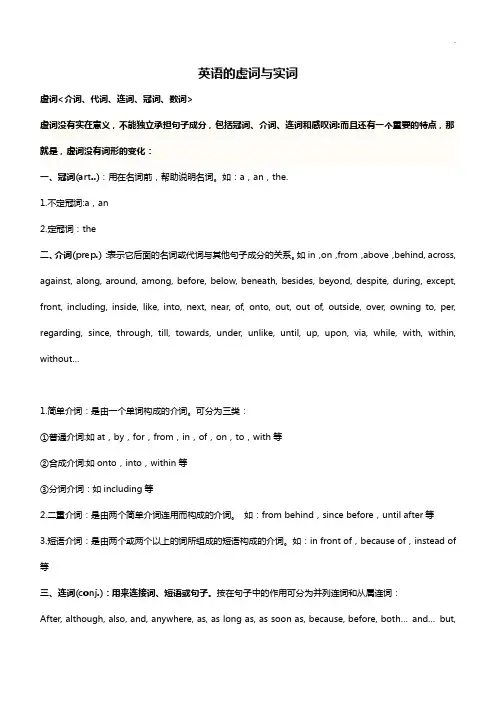
英语的虚词与实词虚词<介词、代词、连词、冠词、数词>虚词没有实在意义,不能独立承担句子成分,包括冠词、介词、连词和感叹词:而且还有一个重要的特点,那就是,虚词没有词形的变化:一、冠词(art..):用在名词前,帮助说明名词。
如:a,an,the.1.不定冠词:a,an2.定冠词:the二、介词(prep.):表示它后面的名词或代词与其他句子成分的关系。
如in,on,from,above,behind, across, against, along, around, among, before, below, beneath, besides, beyond, despite, during, except, front, including, inside, like, into, next, near, of, onto, out, out of, outside, over, owning to, per, regarding, since, through, till, towards, under, unlike, until, up, upon, via, while, with, within, without…1.简单介词:是由一个单词构成的介词。
可分为三类:①普通介词:如at,by,for,from,in,of,on,to,with等②合成介词:如onto,into,within等③分词介词:如including等2.二重介词:是由两个简单介词连用而构成的介词。
如:from behind,since before,until after等3.短语介词:是由两个或两个以上的词所组成的短语构成的介词。
如:in front of,because of,instead of 等三、连词(conj.):用来连接词、短语或句子。
按在句子中的作用可分为并列连词和从属连词:After, although, also, and, anywhere, as, as long as, as soon as, because, before, both…and…but,considering, either…or…even if, even so, even though,, everywhere, for, hence, however, if, in case, in order that, instead of, likewise, never, nevertheless, not only…but also, now that, once, or, otherwise, regardless, since, so, so that, such that, thus, till, until, unless, when, whenever, wherever, whether, where, while…1.并列连词①表示平行或对等关系的并列连词:and,both…and,as well as,not only…but also,neither…nor等②表示转折关系的并列连词:but,yet,while等③表示选择关系的并列连词:or,either…or等④表示因果关系的并列连词:for,so等2.从属连词:是引导从句的连词①引导名词性从句的连词:that,whether,if②引导副词性从句的连词:when,while,as,since,before,after,once,as soon as,until,till,because,now that,although,though,even if,even though,no matter how,no matter what,whatever,however,whether…or,if,unless,so long as,as long as,in order that,so that,so…that,as if,as though,than,where,wherever等四、代词(pron.):主要用来代替名词。
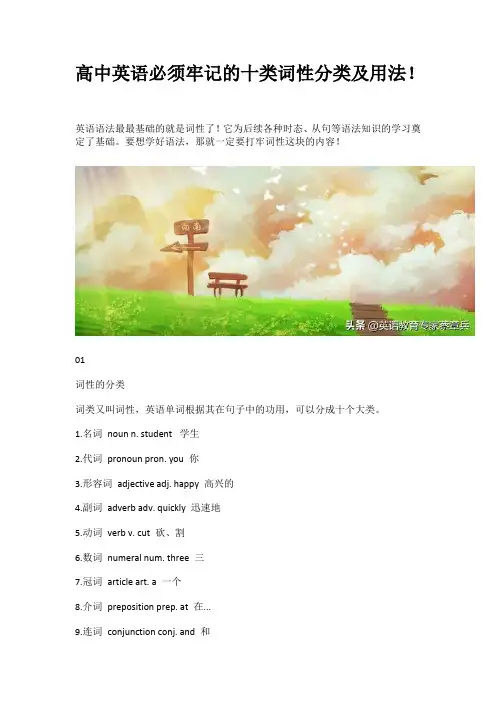
高中英语必须牢记的十类词性分类及用法!英语语法最最基础的就是词性了!它为后续各种时态、从句等语法知识的学习奠定了基础。
要想学好语法,那就一定要打牢词性这块的内容!01词性的分类词类又叫词性,英语单词根据其在句子中的功用,可以分成十个大类。
1.名词noun n. student 学生2.代词pronoun pron. you 你3.形容词adjective adj. happy 高兴的4.副词adverb adv. quickly 迅速地5.动词verb v. cut 砍、割6.数词numeral num. three 三7.冠词article art. a 一个8.介词preposition prep. at 在...9.连词conjunction conj. and 和10.感叹词interjection interj. oh 哦前六类叫实词,后四类叫虚词。
下面就一一介绍:02名词名词复数的规则变化名词的格在英语中有些名词可以加“‘s”来表示所有关系,带这种词尾的名词形式称为该名词的所有格,如:a teacher’s book。
名词所有格的规则如下:1)单数名词词尾加“'s”,复数名词词尾没有s,也要加“'s”,如the boy‘s bag 男孩的书包,men’s room 男厕所。
2)若名词已有复数词尾-s ,只加“'”,如:the workers’ struggle工人的斗争。
03代词大多数代词具有名词和形容词的功能。
英语中的代词,按其意义、特征及在句中的作用分为:人称代词、物主代词、指示代词、反身代词、相互代词、疑问代词、关系代词、连接代词和不定代词九种人称代词的用法I saw her with them,at least, I thought it was her.我看到她和他们在一起,至少我认为是她。
(her做宾语,them做介词宾语,her作主补)a. -- Who broke the vase?--谁打碎了花瓶?b. -- Me.--我。
一、数词讲解1、基数词。
表示数目的多少,如:one, two, three, one hundred, two thousand 等。
2、序数词。
表示顺序第几,其前面须加上定冠词the。
如:the twenty-first, the thirtieth等练习:写出下列数字的基数词和序数词的表示方法。
3、分数。
分数表达法:基数词表示分子,序数词表示分母,如果分子大于1时,分母要加“s”。
如:one-fourth, two-fifths, three-tenths4、年、月、时间表达法:年份用基数词,日期用序数词,时间用基数词,其顺序由小到大。
Eg: He was born on January 11th, 1886. He was born in January, 1990.5、Hundred, thousand, million, dozen, score这些词前面如有表示具体数字的词,它们不能加“s”,反之则须加“s”。
如:three hundred people, thousands of people。
(1) 200 个学生____________________________ (2) 成百上千的人__________________________(3) There are about two _______ students in their school.A. thousand ofB. thousands ofC. thousandD. thousands(4) _______ Iraqi people died in the Iraq War.A. Thousand ofB. Thousands ofC. ThousandD. Thousands(5) _______ students in our school went there this summer.A. Two hundredB. Two hundredsC. Two hundreds ofD. Two hundred of基础练习:(1)He lives on _______ floor. A. four B. fourth C. the four D. the fourth(2) Today she is very happy,because it is her ________ birthdayA. seventeenB. seventeenthC. the seventeenthD. the seventeen (3) This is a big class, and ________ of the students are girls.A. two thirdB. second threeC. two thirdsD. two three(4) -- What is one fourth and a half, do you know? -- Yes, it’s _______.A. two sixthsB. three fourthsC. one threeD. three sixths(5) I like this kind of pen, could you please give me _______ more.A. twoB. secondC. the twoD. the second(6) He has failed many times, but he wants to try _________ time.A. sixthB. a sixthC. the sixthD. six(7) In the final exam, he got _______ prize.A. thirdB. the thirdC. threeD. the three二、介词的用法(一) 介词的功能介词是一种虚词,不能单独使用。